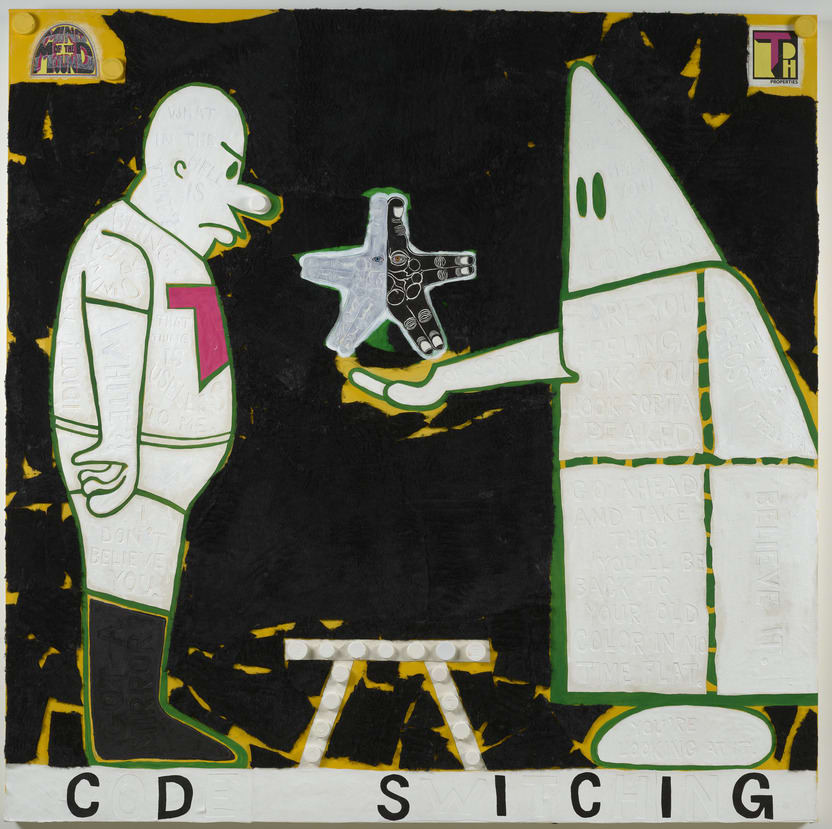
- Artist/Maker:
- Trenton Doyle Hancock
- Bio:
- American, b. 1974
- Title:
- Step and Screw: The Star of Code Switching
- Date:
- 2020
- Medium:
- Acrylic, synthetic fur, graphite, plastic bottle caps, and paper collage on canvas
- Dimensions:
- 84 × 84 in. (213.4 × 213.4 cm)
- Credit Line:
- Purchase: Arts Acquisition Committee Fund
- Accession Number:
- 2021-31
Tags:
Not On View
In this work, Trenton Doyle Hancock imagines a meeting between his avatar Torpedo Boy, a Black superhero, and the controversial Klansman alter ego of the Jewish painter Philip Guston. Guston portrayed himself in the late 1960s and 1970s as a buffoonish hooded figure as a way to ridicule the Klan and thereby diminish the power of its hateful symbolism. It was also an examination of his own complicity in a white-supremacist culture: Guston had changed his name from Goldstein in his youth in response to his family’s conflicts with anti-Semitic Klansmen. His evil alter ego reveals the artist’s conflicted attitude toward his assimilation later in life.
The Klansman here hands the “star of code switching” to Hancock’s Torpedo Boy. (Code switching is the practice of shifting one’s language, appearance, or behavior to meet cultural expectations. Like assimilation, code switching can be a means of self-preservation and social advancement for oppressed groups.) As in a comic book, text embedded in the picture illuminates the conversation between and the inner monologues of the cartoonlike figures. While Torpedo Boy considers the star’s dubious promise (“It will help you live longer”), the perils of code switching are already apparent: Torpedo Boy has turned a ghostly white, as if he has become a reflection of the Klansman himself.
Hancock uses irreverent humor to challenge the legacy of white supremacy in our country, just as Guston once did. As a Black man raised and living in the Southern United States, the artist used his own intergenerational trauma related to the Klan as a catalyst for tackling the subject in his work. Hancock explains, “Generating this encounter was my way to confront an artistic father figure and examine our respective motivations. I wanted to show that hate organizations like the Klan still exist, congregating and operating in plain sight.”
The Klansman here hands the “star of code switching” to Hancock’s Torpedo Boy. (Code switching is the practice of shifting one’s language, appearance, or behavior to meet cultural expectations. Like assimilation, code switching can be a means of self-preservation and social advancement for oppressed groups.) As in a comic book, text embedded in the picture illuminates the conversation between and the inner monologues of the cartoonlike figures. While Torpedo Boy considers the star’s dubious promise (“It will help you live longer”), the perils of code switching are already apparent: Torpedo Boy has turned a ghostly white, as if he has become a reflection of the Klansman himself.
Hancock uses irreverent humor to challenge the legacy of white supremacy in our country, just as Guston once did. As a Black man raised and living in the Southern United States, the artist used his own intergenerational trauma related to the Klan as a catalyst for tackling the subject in his work. Hancock explains, “Generating this encounter was my way to confront an artistic father figure and examine our respective motivations. I wanted to show that hate organizations like the Klan still exist, congregating and operating in plain sight.”
Information may change as a result of ongoing research.